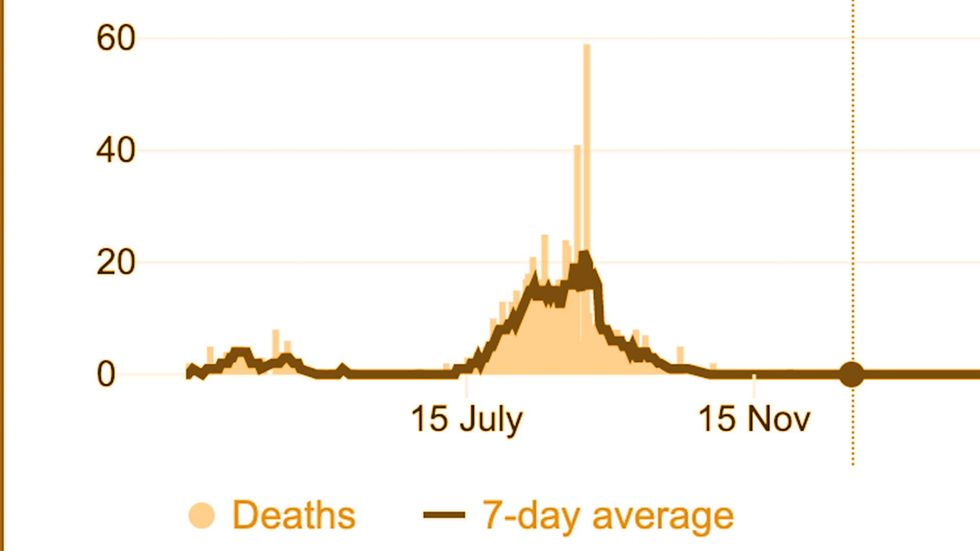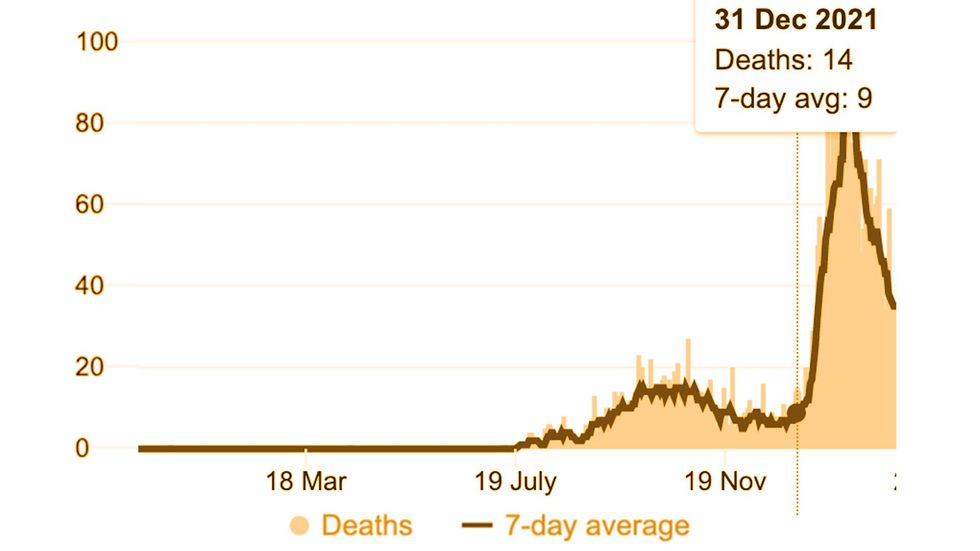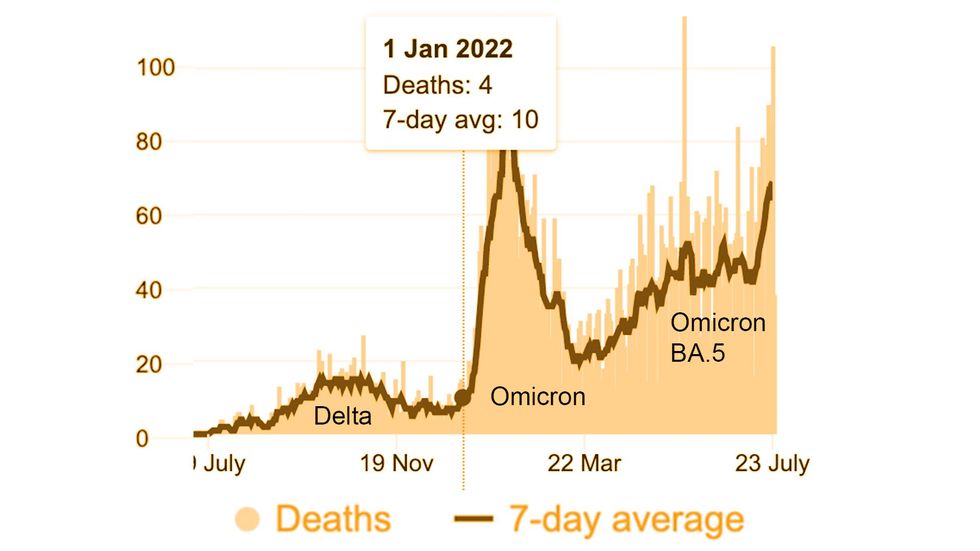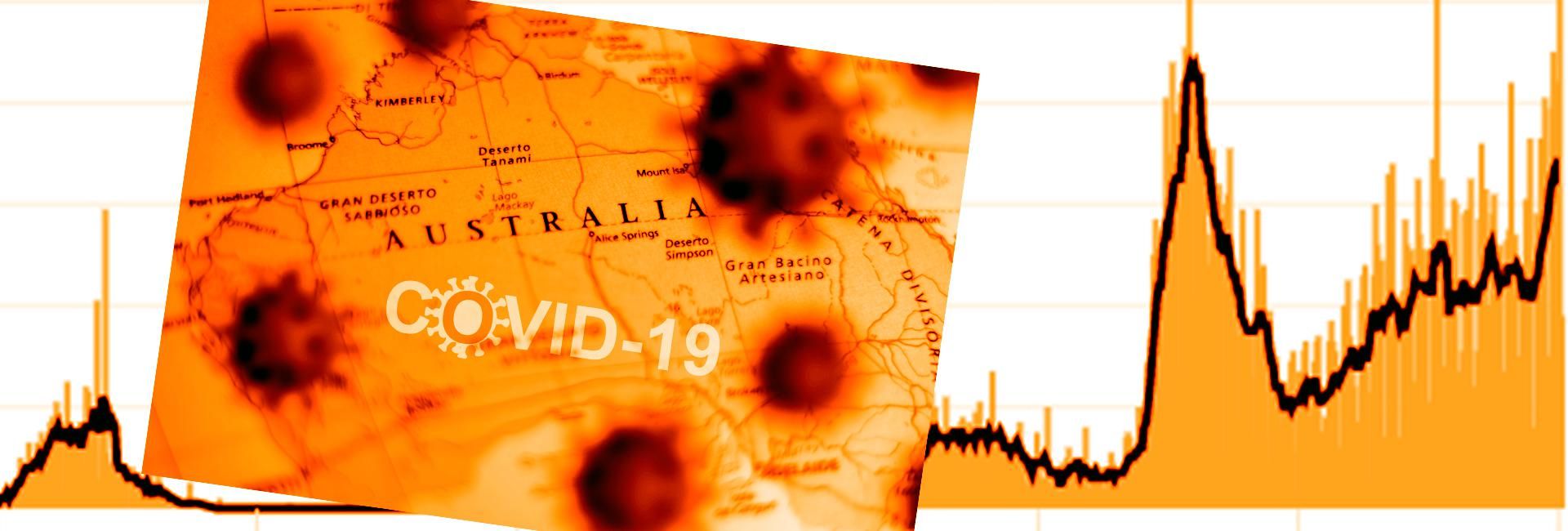Initially recognised as a gold standard for controlling the coronavirus, Australia is now in the top three in the world for COVID deaths per capita.
With the emergence of the highly-transmissible Omicron subvariant BA.5 as Australia’s dominant COVID-19 strain, the infection rate across the country has risen sharply in recent weeks, realising concerns that we are at the start of a deadly new viral surge.
More Australians have died in the past six months than in the previous 20 months of the pandemic. On Saturday, a record daily total of 102 died from COVID and Australia’s cumulative deaths total passed 11,000.
Acknowledging the escalating infections, Prime Minister Anthony Albanese has reinstated COVID sick leave payments for casual workers until September 30. So far, States have made no move to reintroduce mask mandates despite growing calls from public health experts.
Professor Nigel McMillan, of Griffith University, has warned COVID is on track to become the leading cause of death in Australia, overtaking heart disease. “We haven't had an infectious disease be the number one cause of death in 120 years, so if that's not enough for people to realise this is serious then I don't know what is,” McMillan told the ABC.
The impact is being felt around the world. US COVID researcher Eric Topol called the BA.5 subvariant “the worst version of the virus that we’ve seen”. Infections, hospitalisations and deaths are all on the rise.
The Good: ‘Knocking it out of the park’
Early in the pandemic, public anxiety about the virus was high as we religiously tuned in to hear the daily case numbers and death toll from then premier Gladys Berejiklian and Chief Medical Officer Kerry Chant, but our performance in controlling the virus was seen as exemplary

If we go back to 2020, Australia’s seven-day average of COVID case numbers, (the black line on the graph above), reached a modest four-death peak before lockdown brought the first COVID strain, Alpha, under control. The picture was not quite as bright in the second half of 2020 when case numbers in Victoria blew out with a seven-day average peak of 21 deaths in September 2020 — but it was all relative. The United States’ seven-day average peak of 2710 deaths in December, rising to 3341 seven-day average in January 2021.
COVID is on track to become the leading cause of death in Australia, overtaking heart disease.
Around the world, Australia was held up as a country that moved decisively, followed science and saved thousands of lives. Time magazine said Australia had “knocked it out of the park” in its one-year-on review of best global responses to the pandemic.
The Bad: Delta dawn
Entering the second year of the pandemic, there was a relaxed approach to the vaccine rollout, or "strollout" as it was later dubbed. Australia largely had the pandemic under control. By February, all clubs, restaurants and shopping centres had reopened with masks no longer compulsory, just highly encouraged. Some controls remained in place for the number of people allowed to visit homes and places of worship, or to celebrate weddings.

The COVID vaccination rollout began on February 22, 2021 but supplies were limited. “It's not a race," then prime minister Scott Morrison infamously reassured Australians with regard to the slow pace of the rollout, when comparisons were made to vaccination rates in other nations such as Britain and the United States.
By mid-June 2021, it was a race. The number of COVID Delta variant cases were dramatically increasing again with the majority of Australians still without the protection of vaccines. (As the first deaths of the Delta wave were recorded, NSW announced strict new lockdowns for Greater Sydney, Blue Mountains and Central Coast on June 23.) Five-kilometre travel zones were enforced.
During the Delta wave, between July 11 and December 31, 2021, more than 1330 people died across the country, with an average of eight deaths a day at the height of the surge.
Only 6.8 million Australians, less than a quarter, were fully vaccinated. Australians were told double vaccination was the golden ticket to return to normality. By December 23, exactly six months later, 18.7 million people (90%) had been fully vaccinated. In NSW, a staged emergence from lockdown commenced on October 11 when the State reached an 80 per cent double vaccination rate of the eligible population. (Restrictions remained in place for unvaccinated people until December 17.) Mask mandates also eased; even Western Australia reopened the border it slammed shut on March 2, 2020.
The Ugly: Omicron's wake-up call
Double vaccination was supposed to be the golden ticket to freedom. Then came Omicron, surging across the summer and disrupting the vaccine-led return to normality. By January 7, nightclubs were again closed and singing and dancing were banned in pubs. Rapid antigen tests (RATs) were as hard to source as toilet paper at the start of the pandemic.

Since January this year, the number of COVID cases and deaths in Australia has skyrocketed. From January 1 to July 23, cases have increased fourfold from 78,028 to 336,968 cases.
At the start of the year, a total of 2,225 Australians had died of COVID since the pandemic was declared in March 2020. On Monday, the death toll stood at 12,625, more than a fivefold increase in seven months. Deaths per million have increased from 111 to 411. In the early stages of the pandemic, the majority of cases sprang from returning overseas travellers but the Omicron wave is homegrown. The majority of cases have been acquired by an identified local transmission.
Omicron is different in another way too. We never beat it. There was a huge spike in cases, hospitalisations and deaths in the first quarter of 2022, but by mid-March, COVID rates fell just as dramatically as they had risen. However, at the new low point, the seven-day average of deaths was higher than it had been at the peak of deaths in 2021's Delta wave.
Since that March dip, deaths have steadily climbed again thanks to the highly-transmissible Omicron subvariant BA.5, now the dominant strain of the virus in Australia. So, two-and-a-half years into the pandemic, we find ourselves in a dire place. COVID cases, hospitalisations and deaths are back in the daily news bulletins. On Saturday alone, 102 Australians died.
There are also alarming new predictions around Long COVID, which the World Health Organisation defines as a person still has symptoms three months after infection and which last for at least a further two months. Researchers predict up to 5 per cent of Australians who get COVID-19 may then develop the condition. Given 9 million Australians have already contracted the virus since the start of the pandemic, more than 450,000 may develop Long COVID. Without the nation's vaccination take-up, that number would be double.
Australia has fallen a long way from its early position as a gold standard for management of the COVID virus. This week, Australia recorded the third highest COVID deaths per capita of any country, well above the US, Britain, Germany and France. Vaccinations and boosters have helped lessen the impact of the virus for many, but alone they are not enough.
Despite the public health system and its frontline workers being under greater pressure than at any time during the pandemic, Federal and State governments remain reluctant to reintroduce restrictions such as mask mandates because of the public's fatigue with top-down controls on their lives.
Reading the political winds, Australia's Chief Medical Officer Paul Kelly is careful to say it is up to politicians to decide on the introduction of "contentious" mask mandates. However, he has made his views clear, calling on Australians to "wear masks when outside the home in crowded, indoor environments, including on public transport. This is important to protect yourself and others."
If anything was needed to underscore the CMO's message that the pandemic is far from done with us, the Department of Health has confirmed the next mutation of Omicron, BA2.75, has already arrived in Australia.
Oliver is in his third year of a Bachelor of Media (Communications and Journalism) degree at UNSW. He enjoys all things storytelling including, Film, Television, Prose, Poetry and Podcasting. You can find him either on the basketball court or working on a screenplay.
Jasmine is studying a Bachelor of Media (Communication and Journalism) and Arts double degree at UNSW. She is passionate about climate justice, human rights and the environmental humanities. She aspires to be an investigative journalist and has a keen interest in political and environmental issues. In her free time, you'll find her writing, reading or cooking. She also loves to run and her goal is to run a marathon.






Afraid of an egg: the tyranny of living with social media's body standards